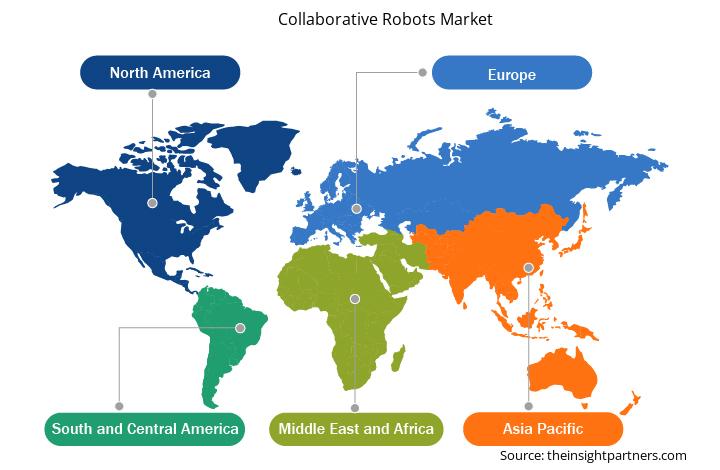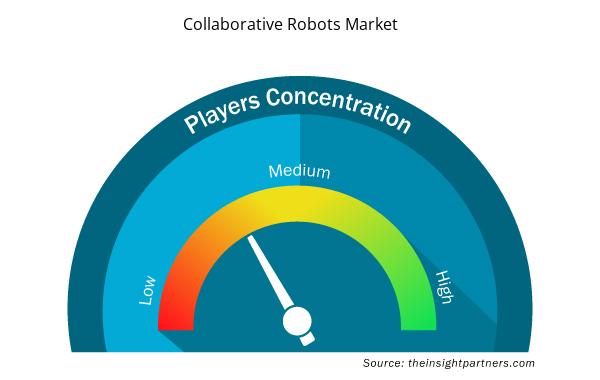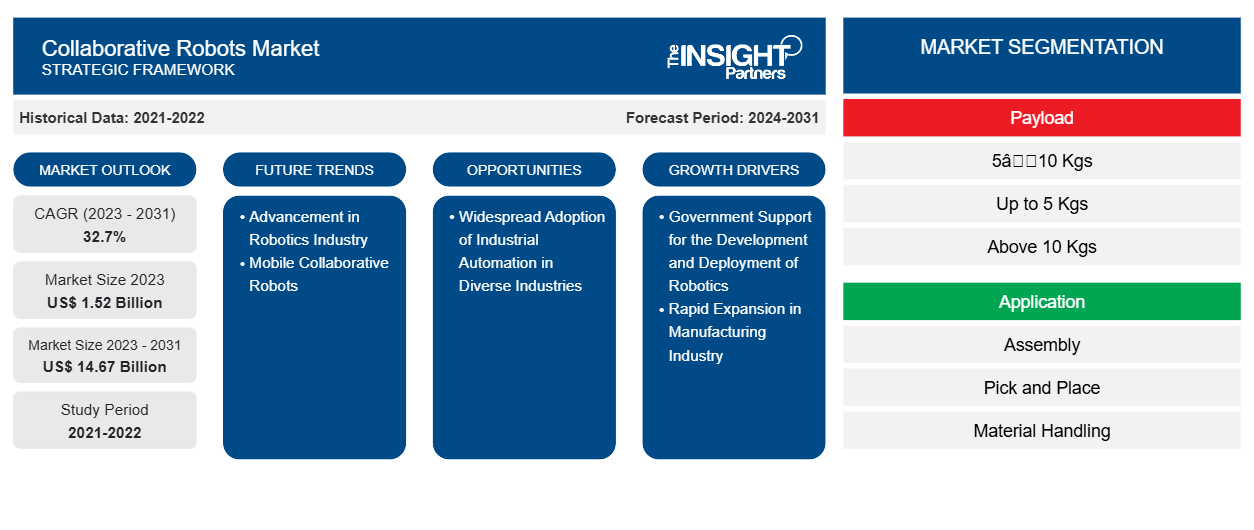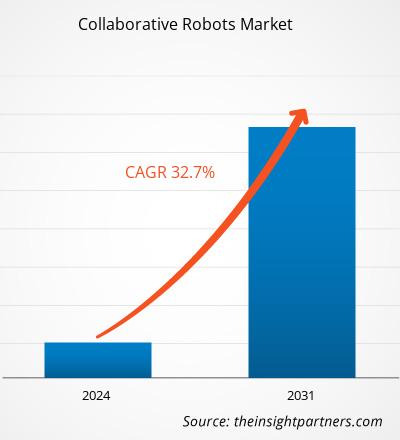Der Markt für kollaborative Roboter soll von 1,52 Milliarden US-Dollar im Jahr 2023 auf 14,67 Milliarden US-Dollar im Jahr 2031 anwachsen. Für den Zeitraum 2023–2031 wird ein durchschnittliches jährliches Wachstum von 32,7 % erwartet. Mobile kollaborative Roboter werden wahrscheinlich neue Trends auf dem Markt mit sich bringen.
Marktanalyse für kollaborative Roboter
Kollaborative Roboter sind eine Gruppe von Servicerobotern, die in der Materialhandhabung, Fertigung und in Laboren eingesetzt werden. Die steigende Nachfrage in Fabriken – insbesondere im Fertigungssektor, wo Menschen und Roboter bereits harmonisch zusammenarbeiten – führt zum Wachstum des Marktes für kollaborative Roboter . Das Aufkommen kollaborativer Roboter hat eine vertrauenswürdige Arbeitsumgebung ermöglicht, in der Menschen sicher mit Robotern zusammenarbeiten können. Zu den wichtigsten Faktoren, die den Markt antreiben, gehören die staatliche Unterstützung für die Entwicklung und den Einsatz von Robotern sowie die schnelle Expansion in der Fertigungsindustrie.
Marktübersicht für kollaborative Roboter
Die Regierungen mehrerer Länder weltweit ergreifen Initiativen, um die Entwicklung und Einführung von Robotern in ihren jeweiligen Ländern zu unterstützen und zu fördern. Solche Initiativen und Maßnahmen der Regierungen dürften das Marktwachstum für Industrierobotik weltweit vorantreiben und damit auch die Nachfrage nach kollaborativen Robotern steigern. Im Jahr 2022 hatte Europa den größten Umsatzanteil am globalen Markt für kollaborative Roboter. In Europa wird erwartet, dass der robuste Automobilsektor und die Präsenz großer Premium-Autohersteller den Markt für kollaborative Roboter ankurbeln werden. Darüber hinaus wird erwartet, dass das Wachstum der Elektrofahrzeugherstellung das Marktwachstum ankurbelt.
Passen Sie diesen Bericht Ihren Anforderungen an
Sie erhalten kostenlos individuelle Anpassungen an jedem Bericht, einschließlich Teilen dieses Berichts oder einer Analyse auf Länderebene, eines Excel-Datenpakets sowie tolle Angebote und Rabatte für Start-ups und Universitäten.
- Holen Sie sich die wichtigsten Markttrends aus diesem Bericht.Dieses KOSTENLOSE Beispiel umfasst eine Datenanalyse von Markttrends bis hin zu Schätzungen und Prognosen.
Markttreiber und Chancen für kollaborative Roboter
Staatliche Unterstützung für Entwicklung und Einsatz von Robotik
Die Regierungen mehrerer Länder weltweit ergreifen Initiativen, um die Entwicklung und Einführung von Robotik in ihren jeweiligen Ländern zu unterstützen und zu fördern. So kündigte die Regierung von Singapur im Rahmen ihres Industry Transformation Program mehrere Maßnahmen an, um Innovation, Automatisierung und Expansion der Unternehmen zu erleichtern und Finanzierungen zu erhalten. Die indische Regierung hat verschiedene Maßnahmen ergriffen, um die intelligente Fertigung in Indien anzukurbeln, darunter das Production Linked Incentive (PLI)-Programm. Als wichtige Regierungsinitiative zur Förderung der Fertigung in Indien wurde das PLI-Programm im Jahr 2020 eingeführt und umfasst 14 Sektoren, darunter Automobil, Pharmazeutika, Textilien, Lebensmittelverarbeitung und Haushaltsgeräte. Darüber hinaus hat die chinesische Regierung mehrere Maßnahmen zur Einführung von Industrierobotik im Fertigungssektor des Landes ergriffen. Dazu gehört der Plan „Made in China 2025“ zur Entwicklung von Hightech-Industrien. Darüber hinaus kündigte die Regierung einen fünfjährigen „Robotics Industry Development Plan“ zur Ausweitung des chinesischen Industrierobotiksektors an . Die Regierung bietet erhebliche Subventionen und Steuererleichterungen für die industrielle Automatisierung. Darüber hinaus umfasst die deutsche Initiative Industrie 4.0 die Entwicklung und den Einsatz von Industrierobotern. Die Regierung kündigte an, zwischen 2016 und 2020 nicht rückzahlbare Barzuschüsse in Höhe von ca. 78 Millionen US-Dollar pro Jahr bereitzustellen, um Forschungsinstitute, Unternehmen und Hochschulen bei der Erforschung der Mensch-Technik-Interaktion zu unterstützen. Derzeit hat die Regierung ca. 300 Studiengänge im Bereich Automatisierung und Robotik zur Verfügung gestellt.
Die südkoreanische Regierung hat einen Investitionsplan in Höhe von 2,7 Millionen US-Dollar angekündigt, den zweiten Basisplan für die Entwicklung intelligenter Roboter 2014–2018. Nach dem Ende des zweiten Basisplans (2014–2018) formulierte die Regierung den dritten Basisplan für intelligente Roboter (2019–2023) und führte ihn durch.
Weitverbreitete Einführung industrieller Automatisierung in verschiedenen Branchen
Die Verbreitung der industriellen Automatisierung nimmt in verschiedenen Branchen außer der Automobilindustrie zu, beispielsweise in der Logistik, der Lebensmittel- und Getränkeindustrie, der Elektro- und Elektronikindustrie sowie der Gummi- und Kunststoffindustrie. In der jüngeren Vergangenheit waren die nichtautomobilen Branchen im Vergleich zur Automobilindustrie unterrepräsentiert. Mit der zunehmenden Funktionalität von Geräten wie kollaborativen Robotern wird erwartet, dass die nichtautomobilen Branchen die Einführung kollaborativer Roboter weiter beschleunigen werden. Die Verbreitung der industriellen Automatisierung nimmt auch in verschiedenen Ländern zu. Industriemärkte wie China, die USA und Japan weisen eine hohe Verbreitung auf; es gibt jedoch auch in den Industriemärkten noch viel Potenzial für weiteres Wachstum. Die Aussichten für weitere Roboterinstallationen sind in vielen dieser Länder bemerkenswert, insbesondere in der Automobilindustrie. Dieses Wachstum ist auf die notwendige Modernisierung und Transformation zurückzuführen, die in diesen Märkten erforderlich ist. Diese Statistiken sind für Hersteller kollaborativer Roboter vielversprechend, da sie den enormen Spielraum für eine weitere Steigerung der Verbreitung anzeigen. Es wird erwartet, dass die geringe Verbreitung im Prognosezeitraum ein beträchtliches Wachstum bewirken wird, solange die Hersteller von der Regierung erheblich unterstützt werden.
Segmentierungsanalyse des Marktberichts für kollaborative Roboter
Wichtige Segmente, die zur Ableitung der Marktanalyse für kollaborative Roboter beigetragen haben, sind Nutzlast, Anwendung, Typ, Endbenutzerbranche und Funktionalität.
- Basierend auf der Nutzlast ist der Markt in 5–10 kg, bis 5 kg und über 10 kg segmentiert. Das Segment 5–10 kg hatte im Jahr 2023 den größten Marktanteil.
- Basierend auf der Anwendung wird der Markt in Montage, Pick-and-Place, Materialhandhabung, Qualitätsprüfung, Maschinenbedienung, Schweißen, Verpackung und andere unterteilt. Das Montagesegment hatte im Jahr 2023 den größten Marktanteil.
- Nach Typ ist der Markt in Roboterarme, Schweißpistolen, Greifer und andere unterteilt. Das Segment der Roboterarme hatte im Jahr 2023 den größten Marktanteil.
- Nach Endverbraucherbranche ist der Markt in Automobil, Elektronik, Metall und Maschinenbau, Lebensmittel und Getränke, Logistik, Pharmazeutika und andere unterteilt. Das Automobilsegment dominierte den Markt im Jahr 2023.
- Nach Funktionalität ist der Markt in statische Roboter und mobile Roboter unterteilt. Das Segment der statischen Roboter dominierte den Markt im Jahr 2023.
Marktanteilsanalyse für kollaborative Roboter nach Geografie
Der geografische Umfang des Marktberichts für kollaborative Roboter ist hauptsächlich in fünf Regionen unterteilt: Nordamerika, Asien-Pazifik, Europa, Naher Osten und Afrika sowie Süd- und Mittelamerika.
Der asiatisch-pazifische Raum hatte im Jahr 2023 einen bedeutenden Marktanteil. Der asiatisch-pazifische Raum besteht aus vielen Entwicklungsländern, die ein signifikantes Wachstum in ihrem Fertigungssektor verzeichnen. Die Region hat sich zu einem globalen Fertigungszentrum mit vielfältigen Fertigungsindustrien entwickelt. Im Zuge der Entwicklung Chinas zu einem hochqualifizierten Fertigungszentrum ziehen andere Entwicklungsländer wie Indien, Südkorea, Taiwan und Vietnam zahlreiche Unternehmen an, die ihre Fertigungsanlagen für geringe bis mittlere Qualifikationsanforderungen in Nachbarländer mit niedrigen Arbeitskosten verlagern möchten. Darüber hinaus fördern die Regierungen dieser Länder Investitionsinitiativen zur Förderung der Fertigungsaktivitäten. Der Mangel an qualifizierten Arbeitskräften, die geringe Produktivität und die fehlende Infrastruktur sind jedoch einige der Hindernisse, die beseitigt werden müssen, um ihre Position als wichtiges Fertigungszentrum in der Region zu stärken.
Die Regierungen der Entwicklungsländer im asiatisch-pazifischen Raum bieten Steuervergünstigungen, Finanzmittel, Subventionen und andere Unterstützungsmaßnahmen an, um Fertigungsunternehmen dazu zu bewegen, ihre Werke in den jeweiligen Ländern zu errichten. Darüber hinaus haben mehrere Regierungen Initiativen wie „Made in China 2025“ und „Make in India“ ergriffen. China, das größte Fertigungszentrum, verzeichnet jedoch aufgrund der alternden Bevölkerung des Landes einen Anstieg der Arbeitskosten. Dies hat dazu geführt, dass Fertigungsunternehmen nach Investitionen in Ländern in Südostasien suchen. Die sich verbessernde Infrastruktur, der steigende Inlandsverbrauch und die niedrigeren Kosten sind einige der Faktoren, die Fertigungsunternehmen in diesen Ländern anziehen.
China ist der weltweit größte Hersteller von Personenkraftwagen. Japan, Indien und Südkorea sind einige der anderen großen Fahrzeugherstellerländer im asiatisch-pazifischen Raum. Neben der Automobilindustrie setzen auch mehrere andere Branchen in China kollaborative Roboter ein. So wurden beispielsweise bei der Xiamen Runner Industrial Corporation – einem der größten Hersteller von Badezimmerzubehör in China – 64 Roboter von Universal Robots an der Produktionslinie für verschiedene Aufgaben eingesetzt, von der Bedienung und Bestückung von Spritzgussmaschinen bis hin zur Produktmontage.
Regionale Einblicke in den Markt für kollaborative Roboter
Die regionalen Trends und Faktoren, die den Markt für kollaborative Roboter im gesamten Prognosezeitraum beeinflussen, wurden von den Analysten von Insight Partners ausführlich erläutert. In diesem Abschnitt werden auch die Marktsegmente und die Geografie für kollaborative Roboter in Nordamerika, Europa, im asiatisch-pazifischen Raum, im Nahen Osten und Afrika sowie in Süd- und Mittelamerika erörtert.

- Holen Sie sich die regionalen Daten für den Markt für kollaborative Roboter
Umfang des Marktberichts über kollaborative Roboter
| Berichtsattribut | Details |
|---|---|
| Marktgröße im Jahr 2023 | 1,52 Milliarden US-Dollar |
| Marktgröße bis 2031 | 14,67 Milliarden US-Dollar |
| Globale CAGR (2023 - 2031) | 32,7 % |
| Historische Daten | 2021-2022 |
| Prognosezeitraum | 2024–2031 |
| Abgedeckte Segmente | Nach Nutzlast
|
| Abgedeckte Regionen und Länder | Nordamerika
|
| Marktführer und wichtige Unternehmensprofile |
|
Marktdichte kollaborativer Roboter: Auswirkungen auf die Geschäftsdynamik verstehen
Der Markt für kollaborative Roboter wächst rasant, angetrieben durch die steigende Nachfrage der Endnutzer aufgrund von Faktoren wie sich entwickelnden Verbraucherpräferenzen, technologischen Fortschritten und einem größeren Bewusstsein für die Vorteile des Produkts. Mit steigender Nachfrage erweitern Unternehmen ihr Angebot, entwickeln Innovationen, um die Bedürfnisse der Verbraucher zu erfüllen, und nutzen neue Trends, was das Marktwachstum weiter ankurbelt.
Die Marktteilnehmerdichte bezieht sich auf die Verteilung der Firmen oder Unternehmen, die in einem bestimmten Markt oder einer bestimmten Branche tätig sind. Sie gibt an, wie viele Wettbewerber (Marktteilnehmer) in einem bestimmten Marktraum im Verhältnis zu seiner Größe oder seinem gesamten Marktwert präsent sind.
Die wichtigsten auf dem Markt für kollaborative Roboter tätigen Unternehmen sind:
- Kuka AG
- Yaskawa America Inc
- Aubo (Beijing) Robotics Technology Co Ltd
- Doosan Robotics Inc
- Fanuc Corp
- ABB Ltd
Haftungsausschluss : Die oben aufgeführten Unternehmen sind nicht in einer bestimmten Reihenfolge aufgeführt.

- Überblick über die wichtigsten Akteure auf dem Markt für kollaborative Roboter
Marktnachrichten und aktuelle Entwicklungen für kollaborative Roboter
Der Markt für kollaborative Roboter wird durch die Erhebung qualitativer und quantitativer Daten nach Primär- und Sekundärforschung bewertet, die wichtige Unternehmensveröffentlichungen, Verbandsdaten und Datenbanken umfasst. Nachfolgend sind einige der Entwicklungen auf dem Markt für kollaborative Roboter aufgeführt:
- OMRON hat die Verfügbarkeit der kollaborativen Roboter der OMRON TM S-Serie angekündigt, die für vielfältige Anwendungen in zahlreichen Branchen entwickelt wurden. Diese Cobots verfügen über fortschrittliche Hardware, mehr Sicherheitsfunktionen und Zertifizierungen sowie Konfigurationsmöglichkeiten der nächsten Generation, wodurch sie einfacher zu bedienen sind als je zuvor. (Quelle: OMRON, Pressemitteilung, September 2023)
- Die TÜV Rheinland Group, eine international führende unabhängige Prüf-, Inspektions- und Zertifizierungsorganisation, hat der ESTUN Automation Co., Ltd. das CE-Maschinenrichtlinie- und Funktionssicherheits-Konformitätszertifikat für ESS-Produkte (ESTUN Safety Solution) ausgestellt. Dies zeigt, dass ESTUN beim Aufbau eines umfassenden Produktssystems für funktionale Robotersicherheit rasche Fortschritte gemacht hat. Diese Zertifizierung zeigt nicht nur die Innovationskraft und das professionelle Niveau von ESTUN im Bereich der Robotertechnologie, sondern spiegelt auch die strenge Kontrolle und das Engagement für Produktsicherheit und -qualität wider und wird die Servicequalität und Effizienz von ESTUN auf dem Weltmarkt weiter verbessern. (Quelle: ESTUN Robotics, Pressemitteilung, April 2024)
Marktbericht zu kollaborativen Robotern – Abdeckung und Ergebnisse
Der Bericht „Marktgröße und Prognose für kollaborative Roboter (2021–2031)“ bietet eine detaillierte Analyse des Marktes, die die folgenden Bereiche abdeckt:
- Marktgröße und Prognose für kollaborative Roboter auf globaler, regionaler und Länderebene für alle wichtigen Marktsegmente, die im Rahmen des Projekts abgedeckt sind
- Markttrends für kollaborative Roboter sowie Marktdynamiken wie Treiber, Einschränkungen und wichtige Chancen
- Detaillierte PEST- und SWOT-Analyse
- Marktanalyse für kollaborative Roboter mit Blick auf wichtige Markttrends, globale und regionale Rahmenbedingungen, wichtige Akteure, Vorschriften und aktuelle Marktentwicklungen
- Branchenlandschaft und Wettbewerbsanalyse, die die Marktkonzentration, Heatmap-Analyse, prominente Akteure und aktuelle Entwicklungen auf dem Markt für kollaborative Roboter umfasst
- Detaillierte Firmenprofile
- Historische Analyse (2 Jahre), Basisjahr, Prognose (7 Jahre) mit CAGR
- PEST- und SWOT-Analyse
- Marktgröße Wert/Volumen – Global, Regional, Land
- Branche und Wettbewerbsumfeld
- Excel-Datensatz


- Micro-Surgical Robot Market
- Space Situational Awareness (SSA) Market
- Pharmacovigilance and Drug Safety Software Market
- Equipment Rental Software Market
- Hydrolyzed Collagen Market
- Long Read Sequencing Market
- Mesotherapy Market
- Lymphedema Treatment Market
- Medical Collagen Market
- Quantitative Structure-Activity Relationship (QSAR) Market

Report Coverage
Revenue forecast, Company Analysis, Industry landscape, Growth factors, and Trends

Segment Covered
This text is related
to segments covered.

Regional Scope
North America, Europe, Asia Pacific, Middle East & Africa, South & Central America

Country Scope
This text is related
to country scope.
Häufig gestellte Fragen
Teradyne Inc., Kuka AG, Yaskawa America Inc., Fanuc Corp, and ABB Ltd. are major players in the market.
The market is expected to reach a value of US$ 14.7 billion by 2031.
The market is anticipated to expand at a CAGR of 32.7% during 2023-2031.
Government support for the development & deployment of robotics and rapid expansion in the manufacturing industry are driving the market growth.
Advancements in the robotics industry and mobile collaborative robots are major trends in the market.
Trends and growth analysis reports related to Electronics and Semiconductor : READ MORE..
The List of Companies - Collaborative Robots Market
- Kuka AG
- Yaskawa America Inc
- Aubo (Beijing) Robotics Technology Co Ltd
- Doosan Robotics Inc
- Fanuc Corp
- ABB Ltd
- Rethink Robotics GmbH
- Techman Robot Inc
- Kawasaki Heavy Industries Ltd
- Bosch Rexroth AG
- Teradyne Inc
- Denso Corp
- Comau SpA
- SIASUN Robot & Automation CO., Ltd
- Agile Robots SE
- Azenta, Inc.
- Svaya Robotics Pvt. Ltd.
- Productive Robotics, LLC
- ESTUN AUTOMATION CO., LTD
- OMRON Corp
The Insight Partners performs research in 4 major stages: Data Collection & Secondary Research, Primary Research, Data Analysis and Data Triangulation & Final Review.
- Data Collection and Secondary Research:
As a market research and consulting firm operating from a decade, we have published and advised several client across the globe. First step for any study will start with an assessment of currently available data and insights from existing reports. Further, historical and current market information is collected from Investor Presentations, Annual Reports, SEC Filings, etc., and other information related to company’s performance and market positioning are gathered from Paid Databases (Factiva, Hoovers, and Reuters) and various other publications available in public domain.
Several associations trade associates, technical forums, institutes, societies and organization are accessed to gain technical as well as market related insights through their publications such as research papers, blogs and press releases related to the studies are referred to get cues about the market. Further, white papers, journals, magazines, and other news articles published in last 3 years are scrutinized and analyzed to understand the current market trends.
- Primary Research:
The primarily interview analysis comprise of data obtained from industry participants interview and answers to survey questions gathered by in-house primary team.
For primary research, interviews are conducted with industry experts/CEOs/Marketing Managers/VPs/Subject Matter Experts from both demand and supply side to get a 360-degree view of the market. The primary team conducts several interviews based on the complexity of the markets to understand the various market trends and dynamics which makes research more credible and precise.
A typical research interview fulfils the following functions:
- Provides first-hand information on the market size, market trends, growth trends, competitive landscape, and outlook
- Validates and strengthens in-house secondary research findings
- Develops the analysis team’s expertise and market understanding
Primary research involves email interactions and telephone interviews for each market, category, segment, and sub-segment across geographies. The participants who typically take part in such a process include, but are not limited to:
- Industry participants: VPs, business development managers, market intelligence managers and national sales managers
- Outside experts: Valuation experts, research analysts and key opinion leaders specializing in the electronics and semiconductor industry.
Below is the breakup of our primary respondents by company, designation, and region:

Once we receive the confirmation from primary research sources or primary respondents, we finalize the base year market estimation and forecast the data as per the macroeconomic and microeconomic factors assessed during data collection.
- Data Analysis:
Once data is validated through both secondary as well as primary respondents, we finalize the market estimations by hypothesis formulation and factor analysis at regional and country level.
- Macro-Economic Factor Analysis:
We analyse macroeconomic indicators such the gross domestic product (GDP), increase in the demand for goods and services across industries, technological advancement, regional economic growth, governmental policies, the influence of COVID-19, PEST analysis, and other aspects. This analysis aids in setting benchmarks for various nations/regions and approximating market splits. Additionally, the general trend of the aforementioned components aid in determining the market's development possibilities.
- Country Level Data:
Various factors that are especially aligned to the country are taken into account to determine the market size for a certain area and country, including the presence of vendors, such as headquarters and offices, the country's GDP, demand patterns, and industry growth. To comprehend the market dynamics for the nation, a number of growth variables, inhibitors, application areas, and current market trends are researched. The aforementioned elements aid in determining the country's overall market's growth potential.
- Company Profile:
The “Table of Contents” is formulated by listing and analyzing more than 25 - 30 companies operating in the market ecosystem across geographies. However, we profile only 10 companies as a standard practice in our syndicate reports. These 10 companies comprise leading, emerging, and regional players. Nonetheless, our analysis is not restricted to the 10 listed companies, we also analyze other companies present in the market to develop a holistic view and understand the prevailing trends. The “Company Profiles” section in the report covers key facts, business description, products & services, financial information, SWOT analysis, and key developments. The financial information presented is extracted from the annual reports and official documents of the publicly listed companies. Upon collecting the information for the sections of respective companies, we verify them via various primary sources and then compile the data in respective company profiles. The company level information helps us in deriving the base number as well as in forecasting the market size.
- Developing Base Number:
Aggregation of sales statistics (2020-2022) and macro-economic factor, and other secondary and primary research insights are utilized to arrive at base number and related market shares for 2022. The data gaps are identified in this step and relevant market data is analyzed, collected from paid primary interviews or databases. On finalizing the base year market size, forecasts are developed on the basis of macro-economic, industry and market growth factors and company level analysis.
- Data Triangulation and Final Review:
The market findings and base year market size calculations are validated from supply as well as demand side. Demand side validations are based on macro-economic factor analysis and benchmarks for respective regions and countries. In case of supply side validations, revenues of major companies are estimated (in case not available) based on industry benchmark, approximate number of employees, product portfolio, and primary interviews revenues are gathered. Further revenue from target product/service segment is assessed to avoid overshooting of market statistics. In case of heavy deviations between supply and demand side values, all thes steps are repeated to achieve synchronization.
We follow an iterative model, wherein we share our research findings with Subject Matter Experts (SME’s) and Key Opinion Leaders (KOLs) until consensus view of the market is not formulated – this model negates any drastic deviation in the opinions of experts. Only validated and universally acceptable research findings are quoted in our reports.
We have important check points that we use to validate our research findings – which we call – data triangulation, where we validate the information, we generate from secondary sources with primary interviews and then we re-validate with our internal data bases and Subject matter experts. This comprehensive model enables us to deliver high quality, reliable data in shortest possible time.


 Holen Sie sich ein kostenloses Muster für diesen Bericht
Holen Sie sich ein kostenloses Muster für diesen Bericht